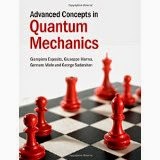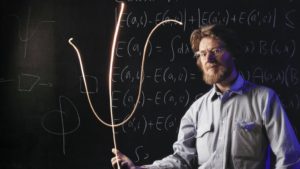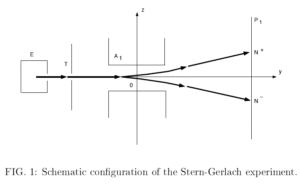Introduction
Hello Everyone.

Some of you may be aware of a mission I have recently joined: to help scientists clean up and add precision to the dialog concerning our chess game of understanding quantum mechanics.
In a recent essay (中文)I outlined a three pronged attack to better teach this topic and better understand the implications. One of these prongs concerns elimination of the terms “nonlocality” and “noncausality” which some authors have been pushing as necessarily implied by experiments and theory of quantum mechanics. The attack we can make with a tempo on this heavily popularized line is a deadly one, and I wrote up and published one version of it under the name “The Emperor Has No Nonlocality” in 2015 (preprint). Today I’m going to go over this game and explain for you how I recommend you play this position on the board.
To briefly review before we get started, “The Emperor Has No Nonlocality” outlines a potentially crushing move against those who wish to push the line that quantum mechanics is incompatible with local realism. We accomplish this by locating the heart of the problem, and demonstrating that it can be explained with local physics.
Well really, I didn’t locate this heart, David Mermin located it for us. Many professors and authors have pointed to Mermin’s immortal description of the EPR paradox as the most accessible one, and the most clear for students or those who might be unfamiliar with some of the notation used by other authors. In this article he even explicitly invites us to solve the puzzle using local physics, which is exactly the path we take, following the work of David Bohm and others. It is my hope that this solution of his gedankenexperiment will enable others to see this opening with a tempo to the heart of nonlocality, and enable us to proceed to tackle more formidable foes and to a much stronger understanding of the physics.
The Gambit Begins
But wait, you say: doesn’t everybody know that quantum mechanics is inconsistent with local physics? What about Bell’s theorem and the associated experimental work?
Indeed, this is where the game gets interesting. Bell’s immortal 1964 paper putting forth his gambit is in my opinion extremely well written. I’ve gone through it dozens of times over more than two decades. It is a miniature, to the point, and doesn’t indulge in the sometimes tempting academic pursuits of lengthening, obfuscation, and over-referencing. If I had to find another paper of this style I would be tempted to mention the Mathematical Theory of Communication by Claude Shannon, and if you know something about my preferences you will know this is the highest compliment I can find for an academic paper. To put it succinctly, Bell plays a sharp game. His game comes in first getting us to accept a set of notations and a definition, after which he leaves us struggling to deal with the consequences.
 John Stewart Bell
John Stewart Bell
The gambit appears immediately in Bell’s equation one, in which he presents a “definition of local realism”, in the context of the Stern-Gerlach experiment:


where

Here we have the results of two measurements  and
and  , measurements of the deflection of two electrons which have passed through Stern-Gerlach devices and been registered on detectors.
, measurements of the deflection of two electrons which have passed through Stern-Gerlach devices and been registered on detectors.
These measurements, according to Bell’s gambit, depend only as calculable functions on the orientation of the relevant measurement apparatus ( or
or  ) and the internal state of the electron prior to entering the device (
) and the internal state of the electron prior to entering the device (  ). The result of this measurement, we are told, can only be up or down (1 or -1), and Bell emphasizes that the measurement
). The result of this measurement, we are told, can only be up or down (1 or -1), and Bell emphasizes that the measurement cannot depend on the orientation of the
cannot depend on the orientation of the apparatus (
apparatus ( ), nor can the measurement
), nor can the measurement  depend on the orientation of the
depend on the orientation of the  apparatus (
apparatus ( ).
).

It certainly is consistent with the use of the word “local” in that if these measurements did depend on the other settings far away, there would be nonlocal behavior at work.
Furthermore, Bell provides us with a means to arrive at a probabilistic distribution – by considering a set of many electron states each  , with some distribution
, with some distribution  . This he handily provides in his equation 2. At this point he tells us already what fate is in store for us – that the probability arrived at by this formalism CANNOT be that predicted by the formalism of quantum mechanics!
. This he handily provides in his equation 2. At this point he tells us already what fate is in store for us – that the probability arrived at by this formalism CANNOT be that predicted by the formalism of quantum mechanics!
At this point the reader is invited to pause the video and follow Bell’s argument, if the reader has not already done so, or if the general mathematical formalism is not appreciated the reader should then read the Mermin version of the EPR paradox which spells out the same line of Bell’s gambit in a specific example and therefore a more accessible and less symbolic manner. Or, for those of you who just want to enjoy the game, simply continue reading.
Bell’s Gambit Accepted
Jose Raul Capablanca tells us that the best way to refute a gambit is to accept it.
The traditional approach here is to accept Bell’s gambit, and allow reference to this basic assumption (Equation 1) as the assumption of “local realism”. Unfortunately this line of reasoning has led to what is usually a losing game (a poor or inconsistent understanding of the physics). One line follows the acceptance of the gambit with pursuit of ever-smaller “loopholes” which will enable experiments to remain in accord with Bell’s principle of local realism. Some experimentalists have become quite stubborn in their insistence that all such loopholes are closed , and if this is true than this line of counterattack is truly over. Others maintain some loopholes remain open. Some of the loopholes proposed certainly seem desperate, while others – not so much. Most notably the “detection efficiency loophole” or “fair sampling loophole” appears quite compelling, and we will see that our suggested line in this piece, Bell’s gambit declined, transposes into something which at least seems quite similar to the detection efficiency loophole. But you will see this later.
The only other line of counterattack following acceptance of Bell’s gambit is to pursue a line which is not dependent on any local realism. This desperation leads to a wide variety of chaotic lines, most of which I believe should simply be resigned. Some people suggest that superluminal signalling is possible (even though no evidence exists for superluminal communication, and signalling should enable communication), or that “multiple universes” might be required (on the microscopic level only?) to explain the behavior, and various other hand-waving. Perhaps even stranger is that some pursue the total denial of objective reality and the suggest that the mere conscious registering of a measurement somehow physically changes the world. At this point it appears we have taken a line of self delusion rather than admit that we have made a blunder.
The trouble is not that these ideas have no merit, it is that they contradict the very point of studying physics to begin with. In fact such “spooky” (a word used all too often in these discussions) lines of reasoning can be taken at the macroscopic level as well. There are many things which cannot be named. There are no shortages of mysteries and if this is your pursuit, I encourage you. I also enjoy such pursuit. However the general goal of a communicable physical theory is precisely to describe some subset of our observations of the world in a consistent and useful model. If our efforts in producing such a coherent model wind up with an incoherent model we need to call spooky, it’s time to admit that we have lost the match and try another strategy. Let’s not forget the object of the game now.
Perhaps we should step back and look at places where we may have blundered in our attempts to understand the physics and return again to the board after a short break.
Bell’s Gambit Declined
Usually pop science reporters are not scientists themselves, in that it is their job to report on what scientists have hypothesized and tested rather than to hypothesize and test things themselves. So you might be surprised then to see that Forbes reporter Chad Orzel hits the nail exactly on the head in his article on “quantum loopholes”:
Quantum particles […] are more strongly correlated than possible with any theory in which the measurement outcomes are determined in advance.
OK, so in much of the article he shows that he has been trapped into following the Bell’s Gambit Accepted line, but in this passage he correctly assesses the content of Bell’s so-called “principle of local realism”. The principle does not include all local realistic theories, but only those local realistic theories in which the outcome of a measurement is exactly determined in advance!
This gives us a line of attack which enables us to decline Bell’s gambit, as we know from basic measurement theory, information science, as well as chaos theory, that with a finite ( i.e. limited ) amount of information  it is impossible to predict the results of future measurements to arbitrary precision. Thus we could say that Bell’s principle of local realism isn’t realistic at all.
it is impossible to predict the results of future measurements to arbitrary precision. Thus we could say that Bell’s principle of local realism isn’t realistic at all.
But that’s not all.
Bell’s gambit also allows for only two outcomes after the electron with state  enters the apparatus: either it orients itself aligned upwards to the field gradient and is deflected upward creating a detection event at the upper plate or it orients itself downwards to the field gradient and is deflected downward creating a detection event at the lower plate. This doesn’t allow for the electron to be deflected elsewhere upon entering the device, including internal absorption or reflection, nor does it allow for the electron to arrive at a dead zone on the detector to not register at all. After all, the detector is never going to have 100% efficiency and so the assumption that
enters the apparatus: either it orients itself aligned upwards to the field gradient and is deflected upward creating a detection event at the upper plate or it orients itself downwards to the field gradient and is deflected downward creating a detection event at the lower plate. This doesn’t allow for the electron to be deflected elsewhere upon entering the device, including internal absorption or reflection, nor does it allow for the electron to arrive at a dead zone on the detector to not register at all. After all, the detector is never going to have 100% efficiency and so the assumption that  cannot be correct. This is where the Bell’s gambit declined line can transpose to look something like the detection efficiency loophole or David Bohm’s “local variable plus nondetection” model. This latter model indeed can explain the predicted (and observed) probabilities while still being a local and realistic theory.
cannot be correct. This is where the Bell’s gambit declined line can transpose to look something like the detection efficiency loophole or David Bohm’s “local variable plus nondetection” model. This latter model indeed can explain the predicted (and observed) probabilities while still being a local and realistic theory.

A bifurcation diagram showing a chaotic system which can branch or quantize chaotically.
To summarize: we can deny that Bell’s equation 1 contains all local theories, because it clearly contains only those local theories which include deterministic binary measurement. This refutation opens up an entirely different line of play in our chess game of understanding quantum mechanics.
We can for example describe the result of the Stern-Gerlach experiment to be at first binary (the electron will go one way or the other), but then take the probability of detection to depend on the original angle of the electron spin. This is the simplest line to play following Bell’s gambit declined, as it enables a local theory consistent with predictions of QM with a minimum of added machinery. We can visualize the electron reorienting itself as it experiences torque in the inhomogenous magnetic field, and then losing some of it’s likelihood of detection (via internal state changes or some sort of deflection) in the process.
However other lines are also possible. The initial binary choice could involve external probabilities as well, and the detection probability could have other dependencies.
Variations after Bell’s Gambit Declined
There are some potential refutations to Bell’s Gambit Declined. One such refutation is to assert that the state  in Bell’s description of local realism can contain not just the internal state of the electron but also every possible externality to arbitrary precision. If this is the case, then indeed the experimental result must be a function of this vector. There is no longer any room for probabilistic measurement if every possible external factor is now included. There is no longer any room to decline the gambit. However such a construction leaves much to be desired. Not only is the size of
in Bell’s description of local realism can contain not just the internal state of the electron but also every possible externality to arbitrary precision. If this is the case, then indeed the experimental result must be a function of this vector. There is no longer any room for probabilistic measurement if every possible external factor is now included. There is no longer any room to decline the gambit. However such a construction leaves much to be desired. Not only is the size of  now necessarily uncountably infinite, but the elements of it are also infinite. The assumption of a “calculable function” now no longer seems to hold. This is an interesting variation but one that appears to be more desperate for the player who is trying to refute Bell’s Gambit Declined. It doesn’t appear to be a comfortable position to play.
now necessarily uncountably infinite, but the elements of it are also infinite. The assumption of a “calculable function” now no longer seems to hold. This is an interesting variation but one that appears to be more desperate for the player who is trying to refute Bell’s Gambit Declined. It doesn’t appear to be a comfortable position to play.
Another potential refutation could come from asking further details of the external factors that can affect the measurement and seeking to poke holes in the exact physical model which appears as the game progresses, and the players continue to refine their physical model of the system at hand (electron + inhomogeneous field + detector apparatus). In this case there will be many other battles over details, but at stake will not be whether the system could be classified as local or nonlocal, but over other details, for example of electron structure or the nature of the interaction with the inhomogeneous magnetic field.
Endgame?
So what then is an electron exactly, and what possible interactions take place as an electron moves through an inhomogeneous magnetic field? Well, good questions – and ones that you aren’t going to find all the answers for right here today.
Perhaps however you have found a way to open your exploration of these issues which doesn’t end in a quick checkmate or stalemate. There are plenty of ways that a model electron could behave, locally and realistically, to obey the laws of quantum mechanics. However there are no ways that it could pass through a Stern-Gerlach device such that our measurement is precisely determined in advance by finite internal or hidden variables in the electron. This is what we have really learned from Bell, Aspect, et al.
Thank you and see you all next time.
Acknowledgements
Agadmator’s chess channel.
Thanks to Agadmator for the vocabulary and format of this post 🙂



 John Stewart Bell
John Stewart Bell
